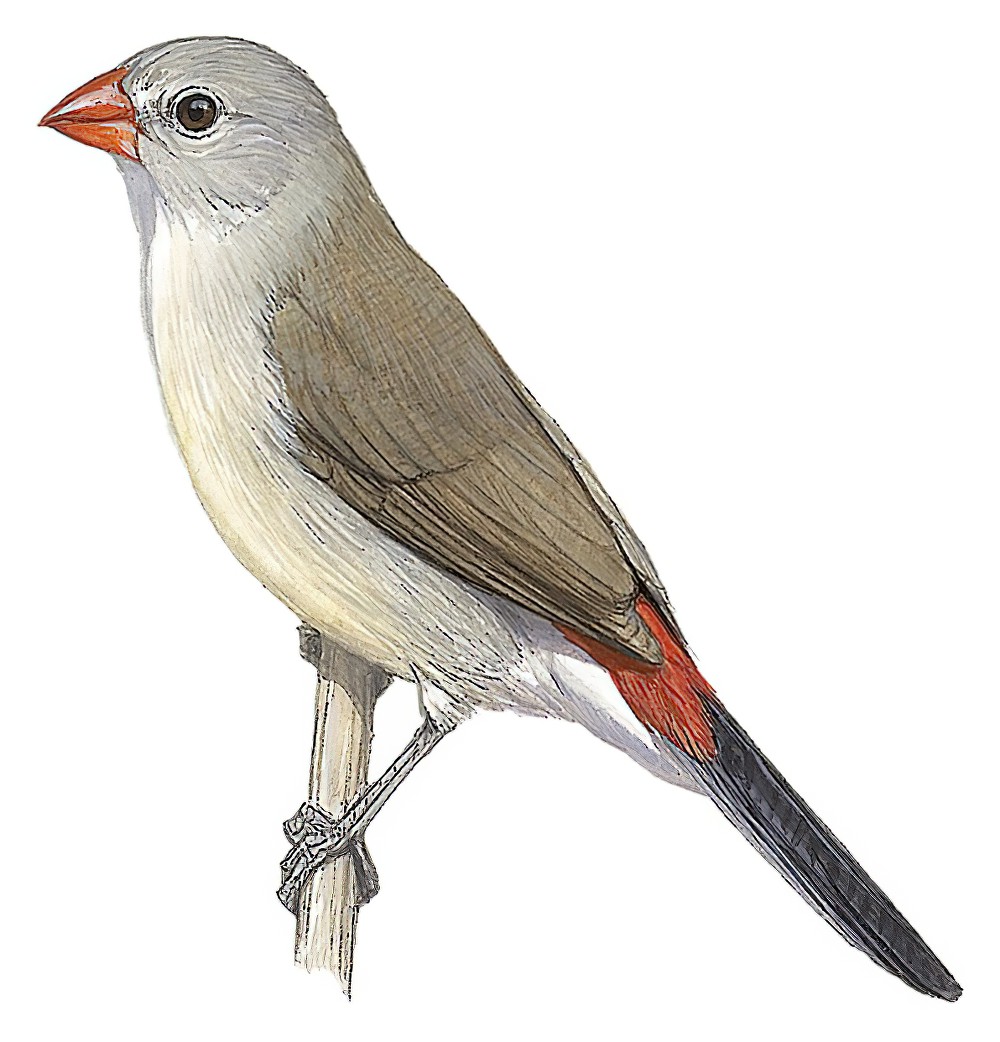Fawn-breasted Waxbill / Estrilda paludicola

Fawn-breasted Waxbill
SCI Name:
Protonym: Estrelda paludicola J.Orn. 11 p.166
Taxonomy: Passeriformes / Estrildidae / Estrilda
Taxonomy Code: fabwax1
Type Locality: middle course of Bahr el Ghazal.
Author: von Heuglin
Publish Year: 1863
IUCN Status: Least Concern
DEFINITIONS
ESTRILDA
(Estrildidae; Ϯ Common Waxbill E. astrild) Specific name Loxia astrild Linnaeus, 1758. It has been suggested that the name derives from a German or Dutch avicultural term for a waxbill. However, an incandescent Reichenbach 1849, wrote that the name Estrelda, from astrild, was neither Latin nor English, nor anything else, and castigated the linguistically proficient authors who foisted it on the scientific community (“Der Name Estrelda, aus Astrild gemacht, ist weder lateinisch noch englisch, noch sonst etwas; man könnte ihn kaum deutsch-englisch nennen und muss erstauen, wie ein paar sprachkundige Männer ihn in die wissenschaft aufzunehmen vorsuchten”); "ESTRILDA. Rostrum breve, conicum, immarginatum. Alæ breves, rotundatæ; remige 1ma spuria, minuta, 3tia, 4ta, et 5ta æqualibus, longissimis. Cauda subelongata, gradata. ... Type. Loxia astrild. Linn. This, and the preceding genus [Amadina], appear strictly confined to the warm regions of the old world; and will detach a vast number of species from the Loxiæ and Fringillæ of Linnæus. I have endeavoured in vain to reconcile the different groups of these birds proposed by Brisson, Cuvier, and Vieillot, with any thing like a geographic or a natural arrangement; and this must be my apology for not adopting either their names or characters; the first would lead to much confusion, while the latter are artificial. The minute spurious quill, (which I have termed, for the sake of uniformity, the first), seems to be an unerring indication of an African or Asiatic origin; and I find the same character in all those I have seen from New Holland." (Swainson 1827); "Estrilda Swainson, Zool. Journ. iii, p. 349, 1827. Type by original designation, Loxia astrild Linn." (W. Sclater, 1930, Syst. Av. Aethiop., II, p. 794).
Var. Astrilda, Estrelda, Estrila.
Synon. Brunhilda, Glaucestrilda, Habropyga, Haplopyga, Krimhilda, Melpoda, Senegalus.
paludicola
L. paludicola marsh-dweller < palus, paludis swamp; -cola dweller < colere to inhabit.
● ex “Hirondelle des Marais” or “Brunette” of Levaillant 1807, pl. 246, fig. 2 (Riparia).
Paludicola
(syn. Hydrornis Ϯ Blue-naped Pitta H. nipalensis) L. paludicola marsh-dweller < palus, paludis swamp; -cola -dweller < colere to inhabit; "Paludicola, nobis. Syimya of the Nipalese, ,,, They feed principally in swamps and rills, upon the hard insects proper to such sites. ... Species new. Paludicola Nipalensis, nobis." (Hodgson 1837).
SUBSPECIES
Fawn-breasted Waxbill (Abyssinian)
SCI Name: Estrilda paludicola ochrogaster
ochrogaster / ochrogastra
Gr. ωχρος ōkhros pale yellow; ωχρα ōkhra yellow-ochre; γαστηρ gastēr, γαστρος gastros belly.
Fawn-breasted Waxbill (Fawn-breasted)
SCI Name: Estrilda paludicola [paludicola Group]
ESTRILDA
(Estrildidae; Ϯ Common Waxbill E. astrild) Specific name Loxia astrild Linnaeus, 1758. It has been suggested that the name derives from a German or Dutch avicultural term for a waxbill. However, an incandescent Reichenbach 1849, wrote that the name Estrelda, from astrild, was neither Latin nor English, nor anything else, and castigated the linguistically proficient authors who foisted it on the scientific community (“Der Name Estrelda, aus Astrild gemacht, ist weder lateinisch noch englisch, noch sonst etwas; man könnte ihn kaum deutsch-englisch nennen und muss erstauen, wie ein paar sprachkundige Männer ihn in die wissenschaft aufzunehmen vorsuchten”); "ESTRILDA. Rostrum breve, conicum, immarginatum. Alæ breves, rotundatæ; remige 1ma spuria, minuta, 3tia, 4ta, et 5ta æqualibus, longissimis. Cauda subelongata, gradata. ... Type. Loxia astrild. Linn. This, and the preceding genus [Amadina], appear strictly confined to the warm regions of the old world; and will detach a vast number of species from the Loxiæ and Fringillæ of Linnæus. I have endeavoured in vain to reconcile the different groups of these birds proposed by Brisson, Cuvier, and Vieillot, with any thing like a geographic or a natural arrangement; and this must be my apology for not adopting either their names or characters; the first would lead to much confusion, while the latter are artificial. The minute spurious quill, (which I have termed, for the sake of uniformity, the first), seems to be an unerring indication of an African or Asiatic origin; and I find the same character in all those I have seen from New Holland." (Swainson 1827); "Estrilda Swainson, Zool. Journ. iii, p. 349, 1827. Type by original designation, Loxia astrild Linn." (W. Sclater, 1930, Syst. Av. Aethiop., II, p. 794).
Var. Astrilda, Estrelda, Estrila.
Synon. Brunhilda, Glaucestrilda, Habropyga, Haplopyga, Krimhilda, Melpoda, Senegalus.
UPPERCASE: current genus
Uppercase first letter: generic synonym
● and ● See: generic homonyms
lowercase: species and subspecies
●: early names, variants, mispellings
‡: extinct
†: type species
Gr.: ancient Greek
L.: Latin
<: derived from
syn: synonym of
/: separates historical and modern geographic names
ex: based on
TL: type locality
OD: original diagnosis (genus) or original description (species)












